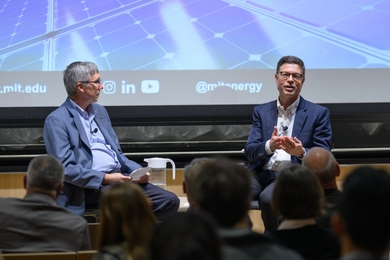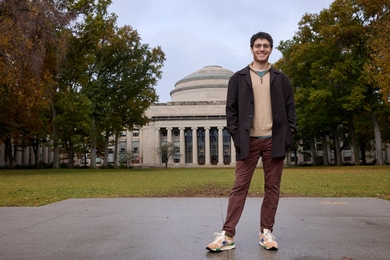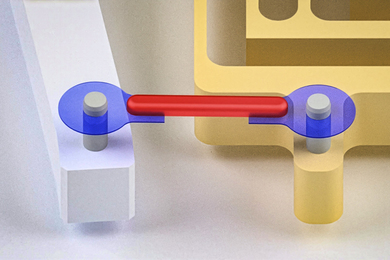In a program that ended on an emotional note -- the announcement that MIT Chairman Paul E. Gray would be leaving his post next June -- reunion class gifts of more than $36 million were announced Saturday, June 8, at MIT's annual Technology Day luncheon for alumni and alumnae.
The luncheon in the Howard Johnson Athletics Center was attended by nearly 900 alumni, alumnae, family and guests, some of the 2,600 who participated in alumni/ae activities this year. The all-day Technology Day program focused on the future effects of science and technology (see related story.
The luncheon program was conducted by Karen W. Arenson (SB in economics, 1970), the 1995-96 president of the Association of Alumni and Alumnae, which has some 90,000 members in 128 countries.
Concluding the luncheon program, Ms. Arenson, an education writer for The New York Times, said she had "bittersweet" news to report -- Dr. Gray's decision to step down next year, announced to the Corporation Friday. Ms. Arenson said she regarded Dr. Gray's wife, Priscilla, as chairman as well, and that both would be stepping away "from the horrendously hectic pace they've been leading on MIT's behalf for so long."
When she asked Dr. Gray and Mrs. Gray to stand -- he came to MIT as a student in 1950 and went on to become president and chairman -- the alumni/ae gave them a prolonged, standing ovation.
Ms. Arenson announced that the most senior alumnus at the luncheon, as he has been for several years, was Malcolm S. (Buzz) Burroughs, 96, of Topsfield, a member of the Class of 1920, observing the 76th anniversary of his graduation. Ms. Arenson also welcomed 188 members of the Cardinal and Gray Society, including the "freshmen" members of the Class of 1946. The Society is an informal association of alumni/ae who have reached their 50th reunion.
Also present, she said, were 18 international alumni and alumnae representing Australia, Canada, Colombia, Ecuador, England, France, Germany, Greece, Israel, Mexico, Panama, Pakistan and Qatar. The graduate who traveled the greatest distance was Gerald Thomas '76 of Australia.
As a highlight of the program, Ms. Arenson announced that the Alumni/ae Association, in keeping with tradition, was bestowing honorary membership on two persons "whose dedication, commitment and loyalty to MIT make them truly extraordinary."
Both were at the luncheon but did not know they would receive the honor. They were Dr. Phillip A. Sharp, Nobel laureate, Salvador E. Luria Professor of Biology and head of the Department of Biology, and Harold "Hatch" Brown, Jr., newly retired assistant professor of physical education, a sailing coach at MIT since 1967 and MIT's sailing master since 1975.
"For some two decades," Ms. Arenson said, Professor Sharp "has made himself available to speak with alumni and alumnae at MIT Club events and other functions about his research and other topics of interest. Despite the many demands on his time in the various roles he has played at MIT, Phil is always ready to listen to a request and see if he can fit a speaking opportunity into his schedule. This was true before he received his Nobel Prize and is still his practice today. Humble and pleasant in manner, Phil has been a most approachable MIT faculty `star' for many years. As someone who has had the pleasure of listening to him, I can also say that he does not just show up, but he is a wonderfully entertaining speaker."
Mr. Brown, Ms. Arenson said, was being honored "for his service to the students and alumni of MIT, and to his careful nurturing of the sailing community." Under his instruction, she said, 20 alumni/ae have been inducted into the College Sailing Hall of Fame. She added that Paula Lewin '93, who became the first Bermudian female ever to win a bronze medal in the 1995 Pan Am Games, gave thanks to "Hatch Brown and MIT's fantastic sailing program." During 29 years of outstanding service to MIT, Ms. Arenson, said Mr. Brown "has won many awards, primarily for his devotion to the sport of sailing, but also for his role as an administrator, manager, coach, teacher and friend in the Department of Athletics."
Gifts for the major reunion classes were presented by Robert N. Schulte for the 25th Reunion Class of 1971, John A. Morefield for the 40th Reunion Class of 1956 and Theodore P. Heuchling for the 50th Reunion Class of 1946.
In addition, Colonel David Bruce Powers, representing the 70th Reunion Class of 1926, which has 72 living members, announced a gift of $5,033,000.
The Class of 1946 announced a gift of $4,306,916.
The Class of 1956 announced a gift of $5,408,000.
The Class of 1971 announced a gift of $1,367,100.
Other reunion gifts announced by Ms. Arenson included: $2,181,759 from the Class of 1931; $13,542,600 from the Class of 1936; $329,287 from the Class of 1941; $1,452,082 from the Class of 1951; $1,910,000 from the Class of 1961; $652,054 from the Class of 1966; $374,955 from the Class of 1976; $61,407 from the Class of 1981; $48,648 from the Class of 1986; $16,909 from the Class of 1991; and the 1996 Senior Class gift and pledge of $21,863.
It also was announced that the Alumni Fund, representing the gifts of non-reunion class alumni/ae and MIT graduate alumni/ae, is expected to reach a record high of $24 million by June 30.
Accepting the gifts, President Vest said, "This kind of sustained, generous support is essential to the vigor and quality of MIT and it is essential to our ability to create the magic that is MIT.
"What do I mean by magic?" he asked. "Magic, to me, has to do with wondrous, and wonderful, transformations. It has to do with creating the unexpected. And it has to do with changing our sense of what is possible."
If he were asked what has struck him most in his five years as president of MIT, he said, he could cite "all kinds of statistical measures of our quality, but what I have been impressed with, over and over again, is the magic of this special place.
"At MIT," he continued, "every day, there are transformations in our idea of what is possible. Here, the invisible is made visible. Here, we extend our reach beyond the human hand. Here, we build things that think. Here, things that were hidden are found. Here, lives are transformed, as students come here and reimagine what their lives might be."
He cited several examples of student and faculty research in this realm and mentioned "all the seniors this spring who told us that when they were in high school, they never could have imagined doing what they are doing now.
"All of this," he said, demonstrates "the quintessential element of MIT magic. The magic of MIT is in its people.
"You are part of that magic," he told the alumni/ae. "You reflect it in your lives. And you help our students and faculty to keep on creating the unexpected and changing our sense of what is possible. MIT makes a profound difference in the nation and the world. Not only do we -- everyone in the room today -- have the ability to dream of a new and better future. We have the ability and the resources to help create it."
On a personal and humorous note, Dr. Vest remarked that he and his wife, Rebecca, were happy to see so many people turn out to celebrate their 33d wedding anniversary.
At the end of the program, Ms. Arenson, who served as the 101st president of the association, handed the symbolic gavel of office to the next president, DuWayne J. Peterson, Jr. Mr. Peterson, a former member of the Corporation, received the SB degree in business and engineering administration from MIT in 1955 and the MBA from the University of California at Los Angeles in 1963. He is president of DuWayne Peterson Associates of Pasadena, CA.
Ms. Arenson introduced the chair of the Technology Day committee, Ron Fergle '86, and paid tribute to the members of the alumni/ae committee and others, including faculty and Alumni/ae Association staff, who helped arrange the program.
Those who served on the committee with Mr. Fergle were Carissa Climaco, Merton Flemings, Kenneth Gordon, Edward Jakush, James Koenig, Paul Levy, Hyun-A Park, Linda Sharpe, Jonathan Spring, A. Robert Wasson and, in an ex officio capacity, James S. Draper, John Preston and Warren Seamans.
A version of this article appeared in MIT Tech Talk on June 12, 1996.





